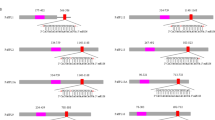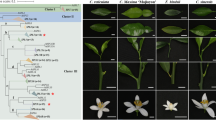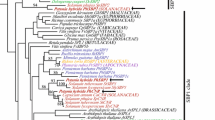Abstract
Key message
Four SPL3/4/5 orthologous genes from Platanus acerifolia were identified, and their structure, expression patterns, role in controlling phase change and ability of inducing early flowering in Arabidopsis were analyzed.
Abstract
Plant flowering behavior is controlled by multiple pathways. The Arabidopsis thaliana SQUAMOSA PROMOTER BINDING PROTEIN-LIKE3/4/5 (AtSPL3/4/5) genes are involved in regulating vegetative phase change. Recent studies have shown that AtSPL3/4/5 genes are directly involved in inducing expression of three flowering integrator genes namely, LEAFY (LFY), FRUITFULL (FUL) and APETALA1 (AP1), thereby triggering flowering. This regulatory integration reveals a commonality of the flowering response with various other plant developmental pathways. We have isolated four SPL3/4/5 orthologous genes (PaSPL3a/b/c/d) from a basal eudicot London plane tree (Platanus acerifolia Wild), a woody species with a long juvenile phase. We investigated the role of these Platanus genes in flowering and detected expression levels between trees in vegetative and reproductive phase. Real-time PCR analysis demonstrated diverse expression patterns for the four PaSPL3 genes throughout the various P. acerifolia tissues, but all four were highly expressed in developing flower bud tissues. Expression of PaSPL3a/b/c in leaves changed according to the season and was regulated by temperature. Furthermore, three of the orthologous were found to induce an early flowering phenotype when overexpressed in Arabidopsis. The findings of this study indicate that PaSPL3 genes may participate in early stage inflorescence development in London Plane. However, there appears to be some divergence in the function of these genes in the control of phase change in London plane as compared to that within Arabidopsis.







Similar content being viewed by others
References
Baurle I, Dean C (2006) The timing of developmental transitions in plants. Cell 125:655–664. doi:10.1016/j.cell.2006.05.005
Cardon GH, Hohmann S, Nettesheim K, Saedler H, Huijser P (1997) Functional analysis of the Arabidopsis thaliana SBP-box gene SPL3: a novel gene involved in the floral transition. Plant J 12:367–377. doi:10.1046/j.1365-313X.1997.12020367.x
Cardon G, Hohmann S, Klein J, Nettesheim K, Saedler H, Huijser P (1999) Molecular characterisation of the Arabidopsis SBP-box genes. Gene 237:91–104. doi:10.1016/S0378-1119(99)00308-X
Chuck G, Cigan AM, Saeteurn K, Hake S (2007) The heterochronic maize mutant Corngrass1 results from overexpression of a tandem microRNA. Nat Genet 39:544–549. doi:10.1038/ng2001
Clough SJ, Bent AF (1998) Floral dip: a simplified method for Agrobacterium-mediated transformation of Arabidopsis thaliana. Plant J 16:735–743. doi:10.1046/j.1365-313x.1998.00343.x
Gandikota M, Birkenbihl RP, Hoehmann S, Cardon GH, Saedler H, Huijser P (2007) The miRNA156/157 recognition element in the 3′ UTR of the Arabidopsis SBP box gene SPL3 prevents early flowering by translational inhibition in seedlings. Plant J 49:683–693. doi:10.1111/j.1365-313X.2006.02983.x
Guo A-Y, Zhu Q-H, Gu X, Ge S, Yang J, Luo J (2008) Genome-wide identification and evolutionary analysis of the plant specific SBP-box transcription factor family. Gene 418:1–8. doi:10.1016/j.gene.2008.03.016
Hou H, Li J, Gao M, Singer SD, Wang H, Mao L, Fei Z, Wang X (2013) Genomic organization, phylogenetic comparison and differential expression of the SBP-Box family genes in grape. PLoS ONE 8:e59358. doi:10.1371/journal.pone.0059358
Huijser P, Schmid M (2011) The control of developmental phase transitions in plants. Development 138:4117–4129. doi:10.1242/dev.063511
Hwan Lee J, Joon Kim J, Ahn JH (2012) Role of SEPALLATA3 (SEP3) as a downstream gene of miR156-SPL3-FT circuitry in ambient temperature-responsive flowering. Plant Signal Behav 7:1151–1154. doi:10.4161/psb.21366
Jung J-H, Ju Y, Seo PJ, Lee J-H, Park C-M (2012) The SOC1-SPL module integrates photoperiod and gibberellic acid signals to control flowering time in Arabidopsis. Plant J 69:577–588. doi:10.1111/j.1365-313X.2011.04813.x
Kim JJ, Lee JH, Kim W, Jung HS, Huijser P, Ahn JH (2012) The microRNA156-SQUAMOSA PROMOTER BINDING PROTEIN-LIKE3 module regulates ambient temperature-responsive flowering via FLOWERING LOCUS T in Arabidopsis. Plant Physiol 159:461–478. doi:10.1104/pp.111.192369
Lannenpaa M, Janonen I, Holtta-Vuori M, Gardemeister M, Porali I, Sopanen T (2004) A new SBP-box gene BpSPL1 in silver birch (Betula pendula). Physiol Plant 120:491–500. doi:10.1111/j.0031-9317.2004.00254.x
Lauter N, Kampani A, Carlson S, Goebel M, Moose SP (2005) microRNA172 down-regulates glossy15 to promote vegetative phase change in maize. Proc Natl Acad Sci USA 102:9412–9417. doi:10.1073/pnas.0503927102
Lawson EJ, Poethig RS (1995) Shoot development in plants: time for a change. Trends Genet 11:263–268. doi:10.1016/S0168-9525(00)89072-1
Li CL, Lu SF (2014) Molecular characterization of the SPL gene family in Populus trichocarpa. BMC Plant Biol 14:131. doi:10.1186/1471-2229-14-131
Li Z, Liu G, Zhang J, Zhang J, Bao M (2008) Extraction of high-quality tissue-specific RNA from London plane trees (Platanus acerifolia), permitting the construction of a female inflorescence cDNA library. Funct Plant Biol 35:159–165. doi:10.1071/FP07212
Li Z, Zhang J, Liu G, Li X, Lu C, Zhang J, Bao M (2012) Phylogenetic and evolutionary analysis of A-, B-, C- and E-class MADS-box genes in the basal eudicot Platanus acerifolia. J Plant Res 125:381–393. doi:10.1007/s10265-011-0456-4
Li J, Hou H, Li X, Xiang J, Yin X, Gao H, Zheng Y, Bassett CL, Wang X (2013) Genome-wide identification and analysis of the SBP-box family genes in apple (Malus x domestica Borkh.). Plant Physiol Biochem 70:100–114. doi:10.1016/j.plaphy.2013.05.021
Lu S, Li Z, Zhang J, Yi S, Liu L, Bao M, Liu G (2012) Isolation and expression analysis of a LEAFY/FLORICAULA homolog and its promoter from London plane (Platanus acerifolia Willd.). Plant Cell Rep 31:1851–1865. doi:10.1007/s00299-012-1299-8
Ma Y, Guo JW, Bade R, Men ZH, Hasi A (2014) Genome-wide identification and phylogenetic analysis of the SBP-box gene family in melons. Genet Mol Res 13:8794–8806. doi:10.4238/2014.October.27.21
Poethig RS (1990) Phase change and the regulation of shoot morphogenesis in plants. Science 250:923–930. doi:10.1126/science.250.4983.923
Poethig RS (2003) Phase change and the regulation of developmental timing in plants. Science 301:334–336. doi:10.1126/science.1085328
Preston JC, Hileman LC (2010) SQUAMOSA-PROMOTER BINDING PROTEIN 1 initiates flowering in Antirrhinum majus through the activation of meristem identity genes. Plant J 62:704–712. doi:10.1111/j.1365-313X.2010.04184.x
Preston JC, Hileman LC (2013) Functional evolution in the plant SQUAMOSA-PROMOTER BINDING PROTEIN-LIKE (SPL) gene family. Front Plant Sci 4:80. doi:10.3389/fpls.2013.00080
Schwarz S, Grande AV, Bujdoso N, Saedler H, Huijser P (2008) The microRNA regulated SBP-box genes SPL9 and SPL15 control shoot maturation in Arabidopsis. Plant Mol Biol 67:183–195. doi:10.1007/s11103-008-9310-z
Subiza J, Cabrera M, Valdivieso R, Subiza JL, Jerez M, Jimenez JA, Narganes MJ, Subiza E (1994) Seasonal asthma caused by airborne Platanus pollen. Clin Exp Allergy 24:1123–1129. doi:10.1111/j.1365-2222.1994.tb03317.x
Usami T, Horiguchi G, Yano S, Tsukaya H (2009) The more and smaller cells mutants of Arabidopsis thaliana identify novel roles for SQUAMOSA PROMOTER BINDING PROTEIN-LIKE genes in the control of heteroblasty. Development 136:955–964. doi:10.1242/dev.028613
Wang J-W, Czech B, Weigel D (2009) miR156-regulated SPL transcription factors define an endogenous flowering pathway in Arabidopsis thaliana. Cell 138:738–749. doi:10.1016/j.cell.2009.06.014
Wang J-W, Park MY, Wang L-J, Koo Y, Chen X-Y, Weigel D, Poethig RS (2011) MiRNA control of vegetative phase change in trees. PLoS Genet 7:e1002012. doi:10.1371/journal.pgen.1002012
Wu G, Poethig RS (2006) Temporal regulation of shoot development in Arabidopsis thaliana by miR156 and its target SPL3. Development 133:3539–3547. doi:10.1242/dev.02521
Wu G, Park MY, Conway SR, Wang J-W, Weigel D, Poethig RS (2009) The sequential action of miR156 and miR172 regulates developmental timing in Arabidopsis. Cell 138:750–759. doi:10.1016/j.cell.2009.06.031
Yamaguchi A, Wu M-F, Yang L, Wu G, Poethig RS, Wagner D (2009) The MicroRNA-regulated SBP-Box transcription factor SPL3 is a direct upstream activator of LEAFY, FRUITFULL, and APETALA1. Dev Cell 17:268–278. doi:10.1016/j.devcel.2009.06.007
Zhang J, Guo C, Liu G, Li Z, Li X, Bao M (2011) Genetic alteration with variable intron/exon organization amongst five PI-homoeologous genes in Platanus acerifolia. Gene 473:82–91. doi:10.1016/j.gene.2010.11.005
Zhang J, Li Z, Guo C, Liu G, Bao M (2013) Isolation and functional analyses of a putative floral homeotic C-function gene in a basal eudicot London plane tree (Platanus acerifolia). PLoS ONE 8:e63389. doi:10.1371/journal.pone.0063389
Acknowledgments
This research was funded by the “Twelfth Five-Year Plan” of the National Science and Technology Research (Grant No. 2012BAD01B04), the National Natural Science Foundation of China (Grant Nos. 31200526 and 31272206), the Forestry Industry Research Special Funds for Public Welfare Projects (Grant No. 201304103) and the Ministry of Education of China (NCET-12-0867 and IRT13065). We thank Dr. Alex C. McCormac (Mambo-Tox Ltd, Southampton, UK) for constructive comments and language editing of the manuscript, and all the colleagues in our laboratory for discussions and technical assistance.
Author information
Authors and Affiliations
Corresponding author
Ethics declarations
Conflict of interest
The authors declare that they have no conflict of interest.
Additional information
Communicated by J. Carlson.
Electronic supplementary material
Below is the link to the electronic supplementary material.
Rights and permissions
About this article
Cite this article
Han, H., Liu, G., Zhang, J. et al. Four SQUAMOSA PROMOTER BINDING PROTEIN-LIKE homologs from a basal eudicot tree (Platanus acerifolia) show diverse expression pattern and ability of inducing early flowering in Arabidopsis . Trees 30, 1417–1428 (2016). https://doi.org/10.1007/s00468-016-1378-5
Received:
Accepted:
Published:
Issue Date:
DOI: https://doi.org/10.1007/s00468-016-1378-5




